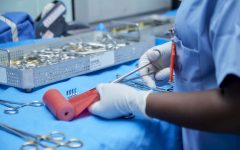Flexible Bronchoscopes and Updated Recommendations for Reprocessing: FDA Safety Communication
January 23, 2021 2021-09-15 23:33Flexible Bronchoscopes and Updated Recommendations for Reprocessing: FDA Safety Communication

Flexible Bronchoscopes and Updated Recommendations for Reprocessing: FDA Safety Communication
The U.S. Food and Drug Administration (FDA) is providing updated information about medical device adverse event reports and recommendations for health care providers on bronchoscopes.
This is a supplement to the 2015 safety communicationExternal Link Disclaimer on reprocessed flexible bronchoscopes.
Recommendations for Patients and Caregivers
The recommendations have not changed from the September 2015 safety communication. The FDA continues to recommend the following:
- Talk to your doctor about the benefits and risks of having a bronchoscopy procedure. The FDA continues to believe that for most patients, the benefits of undergoing bronchoscopy outweigh the risk of infection.
- Ask your doctor what to expect after your procedure. Call your doctor if, after your procedure, you have symptoms such as fever, pain, shortness of breath, increased cough, increased phlegm or mucus, coughing up blood, chest tightness, hoarseness lasting more than two days, and/or increased need for rescue inhaler therapies. These may be signs of a more serious problem.
Recommendations for Health Care Facilities and Staff
The FDA is reminding health care facilities and staff responsible for reprocessing bronchoscopes and their accessories about the importance of carefully following the manufacturer’s reprocessing instructions. Additionally, the FDA recommends the following:
- Consider using sterilization instead of high-level disinfection when feasible, because sterilization has a greater safety margin than high-level disinfection. Steps should include precleaning, leak testing, cleaning, and sterilization.
- If sterilization is not available, then high-level disinfection steps should include precleaning, leak testing, cleaning, high-level disinfecting, rinsing with tap or utility water followed by alcohol flushing or with critical (filtered or sterile) water, and drying.
- Use only manufacturer-specified cleaning accessories, high-level disinfectants, enzymatic cleaning agents, and detergents.
- You should not use damaged devices or those that have failed a leak test, as they could be a potential source of contamination. Examples of damage may include:
- Loose parts
- Damaged channel walls
- Kinks or bends in tubing
- Holes, cracks, or imperfections in the distal end
- Other signs of wear or damage
- After reprocessing, you should store bronchoscopes in a manner that will minimize the likelihood of contamination or collection and retention of moisture, according to manufacturer’s instructions.
- Follow the manufacturer’s recommendations for preventive maintenance and repair of the device and accessories. For additional information, refer to the information provided with your bronchoscope or contact the manufacturer directly.
- Develop schedules for routine inspection and periodic maintenance in accordance with the manufacturer’s instructions. This schedule should include written procedures for training and monitoring compliance with proper reprocessing procedures, and documentation of reprocessing procedures. Staff should be properly trained and wear appropriate personal protective equipment.
- Refer to the American College of Chest Physicians and American Association for Bronchology Consensus Statement, Prevention of Flexible Bronchoscopy-Associated Infection, for further recommendations regarding bronchoscope reprocessing.
- You should not reprocess or reuse single-use bronchoscopes.
Recommendations for Health Care Providers
The FDA continues to recommend the following:
- Discuss the benefits and risks associated with procedures involving reprocessed bronchoscopes with your patients. Discuss signs of a potential infection after a bronchoscopy procedure and when patients should seek medical attention.
The FDA is providing the following new recommendations:
- Consider using a single-use bronchoscope in situations where there is increased risk of spreading infection (for example, multidrug resistant microorganisms, immunocompromised patients, or patients with prion disease) or when there is no support for immediate reprocessing of the bronchoscope.
- When treating patients with Coronavirus Disease 2019 (COVID-19), refer to recent recommendationsExternal Link Disclaimer from the American Association for Bronchology & Interventional Pulmonology (AABIP).
Device Description and Background
A bronchoscope is a type of endoscope, and consists of a thin flexible lighted tube that is threaded through the nose, mouth, or other access point to the lower airways (for example, through a tracheostomy tube), to enable a doctor to examine a patient’s throat, larynx, trachea, and lower airways. A bronchoscope may be used to diagnose abnormalities in the airway, the lungs, or lymph nodes in the chest, or to treat issues such as an object or growth in the airway.
There are two types of bronchoscopes:
- Single-use (disposable) bronchoscopes are only intended to be used for one patient and do not require reprocessing.
- Reusable bronchoscopes can be used on multiple patients. These devices must undergo reprocessing in between uses, to clean the devices of soil and contaminants, and to inactivate microorganisms by sterilization or disinfection.
Reprocessing is a detailed, multistep process to clean and disinfect or sterilize reusable devices including endoscopes. In FDA’s March 2015 guidance document titled Reprocessing Medical Devices in Health Care Settings: Validation Methods and Labeling, bronchoscopes were identified as being part of a subset of devices that pose a greater likelihood of microbial transmission and represent a high risk of infection if they are not adequately reprocessed. When performed according to manufacturer instructions, reprocessing a properly maintained reusable bronchoscope removes soil and microorganisms (including bacteria and viruses, such as SARS-CoV-2) and the bronchoscope is validated for safe reuse. If the reprocessing process is not followed meticulously by trained staff, the bronchoscope can remain contaminated, potentially resulting in infection transmission from one patient to the next. There is also a risk of spreading microorganisms through the air through aerosolization or from the surfaces of the bronchoscope when using and reprocessing a bronchoscope.
Related Posts
Ernestina Dramani
Kate Ansah
Mavis Kissiedy
Search
Popular Tags
Popular tags






